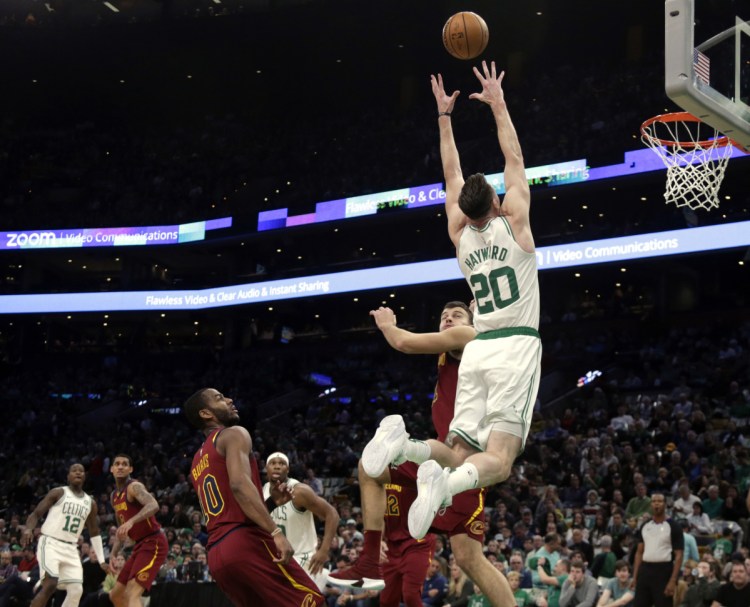Midwestern pride was on the line late Saturday night as Gordon Hayward and Jayson Tatum prepared to leave for the Boston Celtics’ flight home while debating the relative merits of their hometowns, Indianapolis and St. Louis.
All kinds of culture differences were argued, from basketball to music. Tatum wasn’t buying it.
“You’ve got high school basketball,” he chided, before fanning his palms out in a game-over gesture and concluding, “Ya’ll have the Indy 500 and the Final Four. That’s it.”
Country music, Nellie, baseball, the Colts and hip hop were all thrown into the mix. Hayward laughed easily and relaxed, and that’s certainly a mindset he needs in between challenges right now.
Because of the nature of what he’s coming back from – and the accident that caused it – most assume that Hayward’s greatest mental block still involves leaving his feet.
And they’re right, especially when it involves challenging a big man, either off a drive or going up for a lob.
“As I get further into the season my ankle will get stronger and stronger, and then that will translate into confidence going to the rim, and challenging bigs and things like that,” said the Celtics forward. “I still think I’m not there yet on that front. I’ve made a lot of strides as far as my movement is concerned. But I’m still not fully confident as far as challenging bigs at the rim, going for alley-oops and stuff, and getting as high as I’m capable of.”
Though Hayward has engineered some bright flashbacks to his pre-injury self – that 30-point, nine-rebound, eight-assist near-triple-double in Minneapolis on Dec. 1 was more than anyone could have predicted this early in the comeback – his progress still charts like the stock market.
Ups are followed by dips, with recoveries, and then more dips. Hayward had shot 10 for 15 from 3-point range since the Timberwolves game heading into the Celtics’ 113-104 loss in Detroit Saturday night. But that consistency melted on a night when most of his teammates also watched their efficiency drop, and the Celtics’ win streak hit the wall at eight games.
Overall Hayward scored six points on 3-for-11 shooting and missed all four of his 3-point attempts. His two assists were his fewest since Nov. 8, when he had only two at Phoenix. But this was a teamwide problem Saturday, when the Celtics’ ball movement went the way of their shooting.
The Detroit loss also featured the paint presence of Andre Drummond, one of those ball-challenging big men Hayward must once again learn to attack with confidence.
But Hayward’s playmaking has probably been the greatest indicator that his form is returning. Over the 14 games between the Phoenix game and Saturday night, Hayward averaged a hair under five assists.
He’s found a great role as the primary playmaker on the second unit, and that’s simply a matter of developing chemistry with teammates.
That process will be complicated all season by Hayward’s attempt to feel at home physically.
“It’s hard, coming back from the injury he came back from. We commend him,” said Marcus Smart. “We’re proud of him, and he has a lot of work to do just getting back to Gordon. He judges how he feels. But we’re happy for him. We’re here to do everything we can for him. It’s a tough challenge, but I think he’s been taking it very well.”
Indeed, Hayward’s greatest contributions won’t come until he’s again comfortable in his own body.
“Getting healthy and being healthy is the first thing you have to worry about,” said Hayward. “When you’re not healthy you can’t do the things you want on the court. That’s the hurdle I want to go over first, and then I can try to figure everything else out.”
Signs of that other kind of progress, though, are peeking through.
“I think so, because I’m able to do things on the court that I’m used to doing,” said Hayward. “I’m not hesitant, I have more of an aggressive mindset.”
That progress shows in Hayward’s decision-making, a quality that has impressed Brad Stevens ever since the old days at Butler.
“It’s part of the path back, but you’ve seen in the last couple of weeks that there’s a much different comfort level,” said the Celtics coach. “We’ve all got more comfortable with how to play off of him and let him facilitate and make the right decisions with the ball, because he’s so good at that.
“He’s so good in the different pick-and-roll reads, he’s so good as the guy who, if you over-help he’ll make the right pass every time,” said Stevens. “That’s taken a while for everyone to get used to, get acclimated to. And then the idea of having to come back and get physically acclimated anyways, like I’ve said, he’ll be better in Game 40 than 20 and 60 than 40. That’s the path that he’s on.”
Said path certainly looks clearer now than in November.
“Each and every game Gordon looks more comfortable out there, more confident,” said Smart. “He’s getting his swagger back. We’ve all been clicking, and it’s something we have to stick to and make sure we keep it going. We’re always telling him we’re waiting for him to be the Gordon he feels he should be, and once he gets there he’ll be good.”
Send questions/comments to the editors.



Comments are no longer available on this story